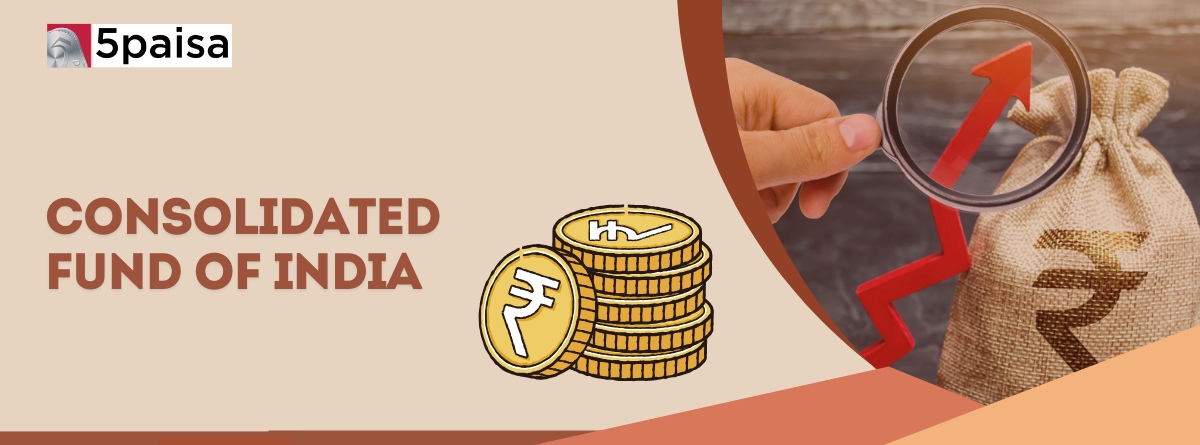Content
What is Consolidated Fund of India?
The Consolidated Fund of India is established by Article 266(1) of the Indian Constitution. This fund collects all government income, including taxes, fees, duties, & other receipts; it also holds government-issued loans & loan recoveries.
This fund's balance pays for the government's regular outlays on debt service, infrastructure projects, defense, wages, pensions, & other expenses.
The government is in charge of the Consolidated Fund, but Parliament must approve the use of its funds, which is done by passing appropriations bills. The types & quantities of costs that can be withdrawn are specified in these bills.
Unlock the full article - sign in with Gmail!
Expand Your Market Knowledge with 5paisa Articles
Consolidated Fund of India
The Consolidated Fund ensures accountability & transparency in public finance by combining all government receipts & outlays into a single account. It guarantees that expenditures are authorized & consistent with budget goals while also assisting the government in efficiently managing its finances.
The fact that no money may be taken out of this fund without the consent of Parliament is a crucial point to remember. The necessity of legislative authorization guarantees accountability & openness in the distribution of resources. Moreover, every Indian state has the ability to create its own Consolidated Fund of State, which would replicate the organization & policies of the national government. The consolidated fund of India meaning essentially refers to the central government's key financial resource.
The Consolidated Fund of India Formation
The government of India's total receipts, total loans acquired through the issuing of treasury bills, loans, or other advances, & total loan repayments are all combined to create the Consolidated Fund of India. This fund is used on behalf of the Indian government to make all legally required payments.
All government costs are reimbursed from this fund, with the exception of unusual items, which are covered by funds from the Public Account or the Contingency Fund. The government of India's total receipts, total loans acquired through the issuing of treasury bills, loans, or other advances, & total loan repayments are all combined to create the
Consolidated Fund of India. This fund is used on behalf of the Indian government to make all legally required payments.
All government costs are reimbursed from this fund, with the exception of unusual items, which are covered by funds from the Public Account or the Contingency Fund.

Consolidated Fund of India: Components
Now that you understand what a consolidated fund is, let's look at its major elements. The main divisions of the
Consolidated Fund of India are as follows:
1. Receipts from the Capital Account;
2. Disbursements from the Capital Account;
3. Receipts from the Revenue Account;
4. Disbursements from the Revenue Account; &
5. Disbursements Charged on the Consolidated Fund.
Revenue Sources for the Consolidated Fund of India
All government revenue is deposited into the Consolidated Fund of India, which is derived from a number of sources & transactions. Among them are:
1. Income from Indirect Taxes: A sizable portion of the fund is comprised of indirect taxes, such as the Goods & Services Tax (GST). At the moment of sale or consumption, these taxes are applicable to products & services.
2. Income from Direct Taxes: This includes income tax derived from both corporations & private citizens. Taxes on investments, salaries, & corporate earnings are all included.
3. Revenue from Government Services: In addition, the fund contains revenue from providing a variety of governmental services & initiatives, including licenses, permits, & administrative fees.
4. Profits & Dividends from Public Sector Enterprises: With the money they make from their operations, Public Sector Undertakings (PSUs) make a contribution. The government's revenue is greatly increased by these state-owned enterprises.
5. Proceeds from Disinvestment, Loan Recoveries, & Debt Repayments: Selling government assets, loan recoveries, & debt repayments are all included in this part. These monies are obtained through the recovery of overdue debts & prudent divestitures.
Expenditure Charged on the Consolidated Fund of India
The Consolidated Fund of India is also used to pay for a number of important costs that don't need approval from parliament. We call these costs non-votable. The costs consist of:
1. Salaries for Members of Parliament: This includes the Deputy Speaker of the Lok Sabha, the Chairman & Deputy Chairman of the Rajya Sabha, & their allowances.
2. Judges' Salary & Pensions: This covers the allowances, pay, & pensions of justices of the Supreme Court. The Consolidated Fund of India is also used to pay high court judges' pensions.
3-Expenses Associated with the President's Office: These comprise the salary, benefits, & other costs associated with the office of the President of India.
4-High Court Judge Pension: It's crucial to remember that the Consolidated Fund of India, not the State Government, is responsible for funding high court judges' pensions.
5. Supreme Court Expense: This fund is used to cover all administrative costs associated with the Supreme Court, such as staff & judge salaries, benefits, & pensions.




